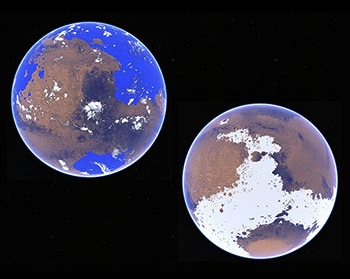 The high seas of Mars may never have existed. According to a new study that looks at two opposite climate scenarios of early Mars, a cold and icy planet billions of years ago better explains water drainage and erosion features seen on the planet today. (…)
The high seas of Mars may never have existed. According to a new study that looks at two opposite climate scenarios of early Mars, a cold and icy planet billions of years ago better explains water drainage and erosion features seen on the planet today. (…)
The idea that 3 to 4 billion years ago Mars was warm, wet and Earth-like with a northern sea—conditions that could have led to life—is generally more popular than that of a frigid, icy planet where water is locked in ice most of the time and life would be hard put to evolve. To see which early Mars better explains the modern features of the planet, Robin Wordsworth [Harvard University] and his colleagues used a three-dimensional atmospheric circulation model to compare a water cycle on Mars under different scenarios 3 to 4 billion years ago…
The study’s authors found that the cold scenario was more likely to have occurred than the warm scenario, based on what is known about the history of the Sun and the tilt of Mars’ axis 3 to 4 billion years ago…. A paper presenting the results has been accepted for publication in the Journal of Geophysical Research – Planets. [More at links]








